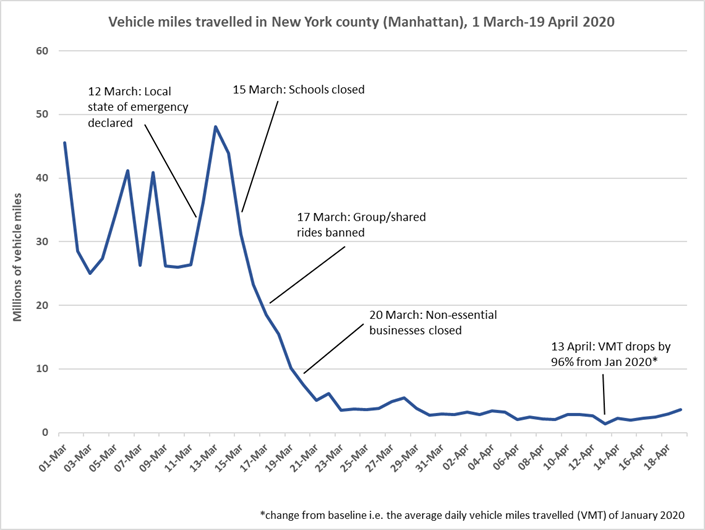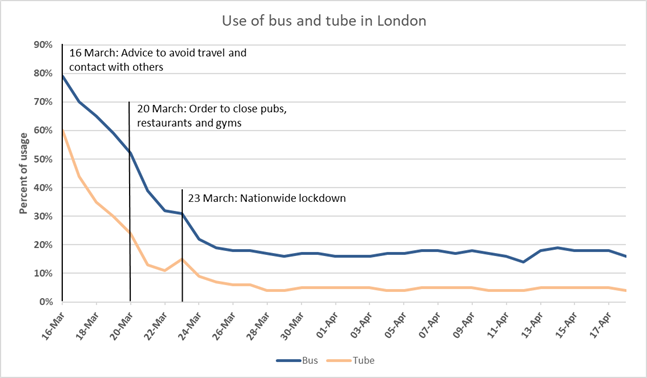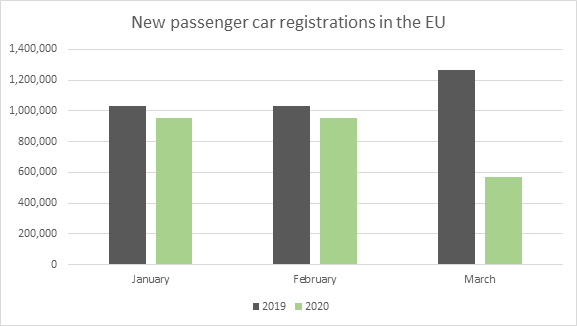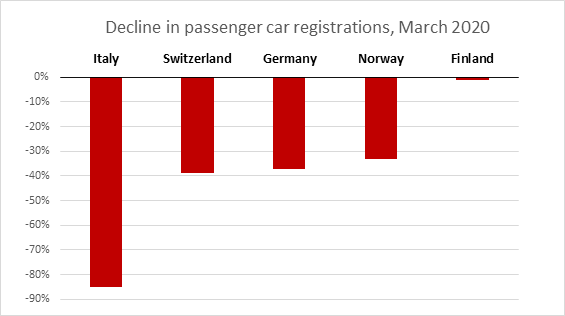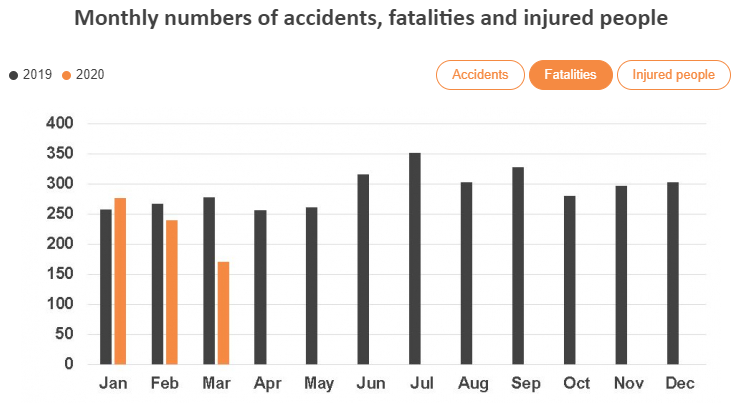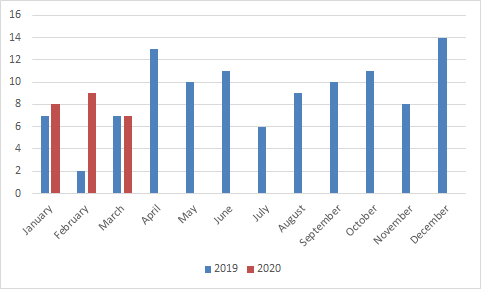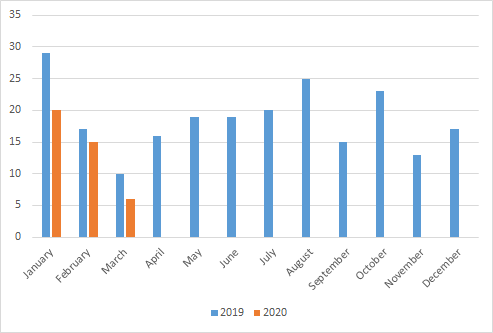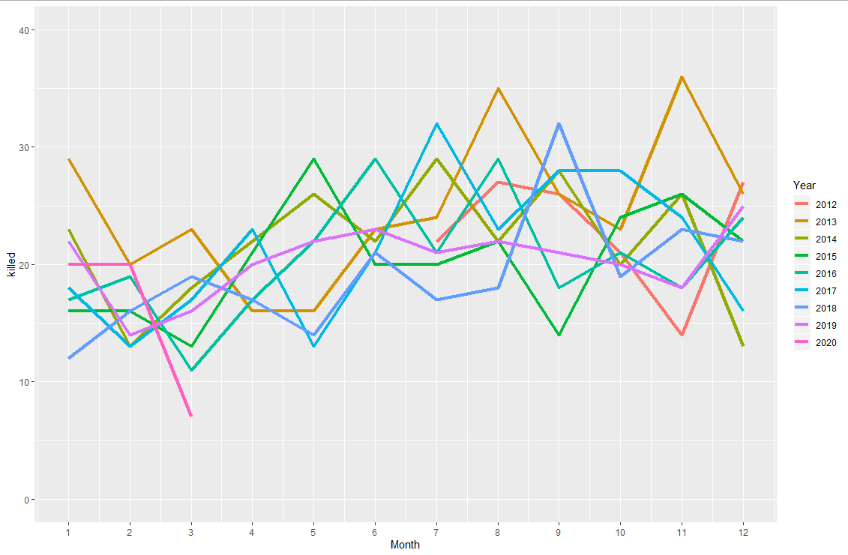Restrictions put in place due to the Coronavirus pandemic have changed the way we live, shop, spend our free time, and the way we move. In many cities, streets have cleared of usual traffic. Public transport has been reduced and the bus, tram and train lines that still operate are used by only a handful of people. The big question is what will happen once the crisis is over. Will traffic return to normal, or could the pandemic spark a lasting change in urban mobility?
Traffic down, cycling up
The chart below shows how traffic levels in New York county (Manhattan) plunged shortly after a local state of emergency was declared in New York City. On 13 March, vehicle miles travelled still reached almost 50 million, but within a week they dropped to less than 10 million, following the adoption of restrictions on schools, businesses and mobility.
Source: Streetlight Data VMT Monitor
An obvious explanation to the drop in vehicle miles is that people simply stayed at home. As social distancing was encouraged and schools and businesses closed, the need to move from place to place was no longer there. However, the New York City Department of Transportation reports that during March and after encouragement from the Mayor of New York City to avoid crowded public transport, there has been a significant, 50 per cent, increase in cycling.
Many European cities are seeing similar effects and are putting in place measures to make cycling in cities safer and easier. In Berlin, where road traffic has fallen by 40 per cent, bike lanes have been widened and extended to increase safety and give more space to cyclists and pedestrians.
The city of Budapest reports that due to the pandemic the number of passengers on city buses has fallen by 90 percent while vehicle traffic is down by 50 per cent. People are looking for alternative ways of moving from place to place and cycling has emerged as an attractive option. Budapest is increasing the number of bike lanes and the city has also decreased the rental price of citybikes. While these measures currently are temporary, depending on their success, they can become permanent in the future.
Source: GOV.uk
Plans for the future
In some cities, the pandemic situation has eased to the extent that it is possible to start planning for return to normal life. But normal doesn’t need to mean the same as before. Brussels has put forward plans to prioritize cyclists and pedestrians in the city centre. This is to make it easier for people to move while still maintaining a level of social distancing. The plan includes reducing vehicle speed limits to 20km/h and giving pedestrians and cyclists priority to move on streets, not just sidewalks and bike lanes.
The municipality of Milan has proposed an ambitious plan to encourage cycling and walking in the city centre. Milan has been in the epicentre of the Corona crisis in Europe and has had to cut public transport. The municipality doesn’t want to see public transport replaced by private cars, therefore they are heavily investing in sustainable mobility. The plan is to create temporary bike lanes, enlarge sidewalks, and set speed limits for vehicles to 30 km/h. During the summer, Milan plans to transform 35 km of road to better serve cyclists and pedestrians.
For some cities these kinds of measures have been in the plans even before the pandemic hit. For example, New York City has been focusing on the safety of cyclists and building new bike lanes since 2014. Brussels decided last year to reduce vehicle speed limits in the city to 30km/h starting 2021.
Long term impacts?
It will be interesting to see what impacts the pandemic will have on urban mobility in the long run. Cities already on the path to make city centres more pedestrian and biker friendly will most likely continue on their chosen track. If feedback is encouraging, it might push cities that are now putting in place temporary measures to increase the safety of cyclists to make them permanent. The more cities can report positive outcomes, the more likely it is that cycling as the main mode of transport in urban areas will become a major trend.
The Coronavirus pandemic has led countries to restrict the movement of citizens, which can be seen in reduced traffic on most modes of transport. Economic activity has also slowed down as shops and services have been closed. One of the industries hit is the car industry, with demand for new vehicles falling compared to previous years. This is reflected in the number of vehicle registrations, which has dropped considerably.
Data from the European Automobile Manufacturers Association show that the economic impact on the car industry has been significant. In the European Union, new passenger car registrations began to decline at the start of the year, and in March they fell by over 50 per cent year-on-year.
Source: ACEA
Italy
Countries struggling most with the pandemic have seen the largest drops in vehicle registrations. For example, in Italy, during January-March 2020 new car registrations fell by 35 per cent compared to the same period in 2019. In March 2020 alone, vehicle registrations dropped by 85 per cent compared to the previous year.
Switzerland
According to the Federal Statistical Office, vehicle registrations in Switzerland have also been on the decline since the start of the year. In January, new registrations of passenger cars fell by 10 per cent, in February by 14 per cent, and in March the drop was 39 per cent, compared to corresponding months in 2019. Interestingly, March data shows that as registrations of new petrol and diesel cars have almost halved, registrations of hybrid vehicles has actually grown by over 60 per cent.
Germany
In Germany the trend in new vehicle registrations has been similar to that in Switzerland. Vehicle registrations began to decline in January and fell by 37 per cent in March. Comparing the 2020 January-March period to 2019, there have been 20 per cent less vehicle registrations in Germany.
Norway
Similar trends can be seen beyond Central Europe. In Norway, the number of new vehicle registrations fell in March by 33 per cent compared to 2019. However, the decline didn’t start until February. In January, vehicle registrations still increased, although by a very slight 0.3 per cent. Altogether, in January-March 2020 there were 18 per cent less new car registrations compared to the same period in 2019.
Finland
On the other end of the spectrum, in Finland, the number of new passenger cars registered has not yet seen any notable decline. According to Statistics Finland, there was a decline of 0.9 per cent in the number of new passenger cars registered in March. During the period January-March 2020, registrations fell by about 3 per cent compared to the same period in 2019.
Source: National Statistical Offices or other national agencies and UNECE calculations
Importance of this indicator
The number of new vehicle registrations is less important than e.g. traffic volumes as a measure of how transport activity has changed, but it is very revealing as an indicator of how economic activity is being affected. It is also possible that in the medium term the reduced take-up of new vehicles will have a marginal impact on issues like road safety and air quality, as newer cars are typically safer and cleaner.
Given possibly record reductions in motorised traffic due to various lockdowns caused by the Coronavirus, much interest lies in timely road safety data (even if provisional). As of today, here are a few interesting examples. Each of these is linked to on the main page, and all data should be considered provisional.
France
The French Road Safety Observatory preliminary data show that in March 2020, 154 lost their lives on the roads of Metropolitan France. This is a 39% drop compared to the same period of 2019, and a 29% drop compared to February 2020.
Norway
Provisional data for March 2020 show fatality levels identical to March 2019.
Sweden
In March 2020, 6 people died on the roads in Sweden. This is the lowest figure since monthly data have been published (going back to 2003), and is a 40% reduction on the March 2019 figure.
London, United Kingdom
13 people are recorded as road traffic fatalities by Transport for London in March 2020, making 40 fatalities for 1Q2020 in total, which is actually an 11% increase compared to 1Q2019. (The UK was only put into formal lockdown on 23 March).
New York City, United States
Daily traffic crashes reported by the New York Police Department show that in March 2020, seven road traffic fatalities occurred, which is the lowest monthly figure since the series begins in July 2012.
*Data manipulated and graphed in R by UNECE. A basic R-script is available that allows monthly data to be downloaded.
This page will be updated when notable examples of statistics sources that show the Coronavirus impact on transport systems become available.
